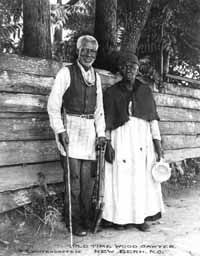![[Previous]](images/prev.gif)
![[Next]](images/next.gif)
I felt like a bird out of a cage. Amen. Amen. Amen. I could hardly ask to feel any better than I did on that day.
-- Houston Holloway, former slave from Georgia recalling the moment that slavery ended
While Union victory in the South brought an end to slavery, most plantation estates remained intact and under white ownership after the Civil War. African Americans were now free to leave but many, having no reasonable options, stayed on with their former owners and continued to work for a few more years as tenants or as sharecroppers. However, emancipation brought about a significant transformation for black people and word of their release was received with intense joy. Eda Harper, a former slave from Mississippi, remembered that when her mother- in-law learned that she was free "she sent and got all the neighbors and they danced all night long."
 Elderly Couple from New Bern, North
Carolina (23.1)
Elderly Couple from New Bern, North
Carolina (23.1)
Next section of The Cultural Landscape of the Plantation Exhibition
Table of contents for The Cultural Landscape of the Plantation Exhibition